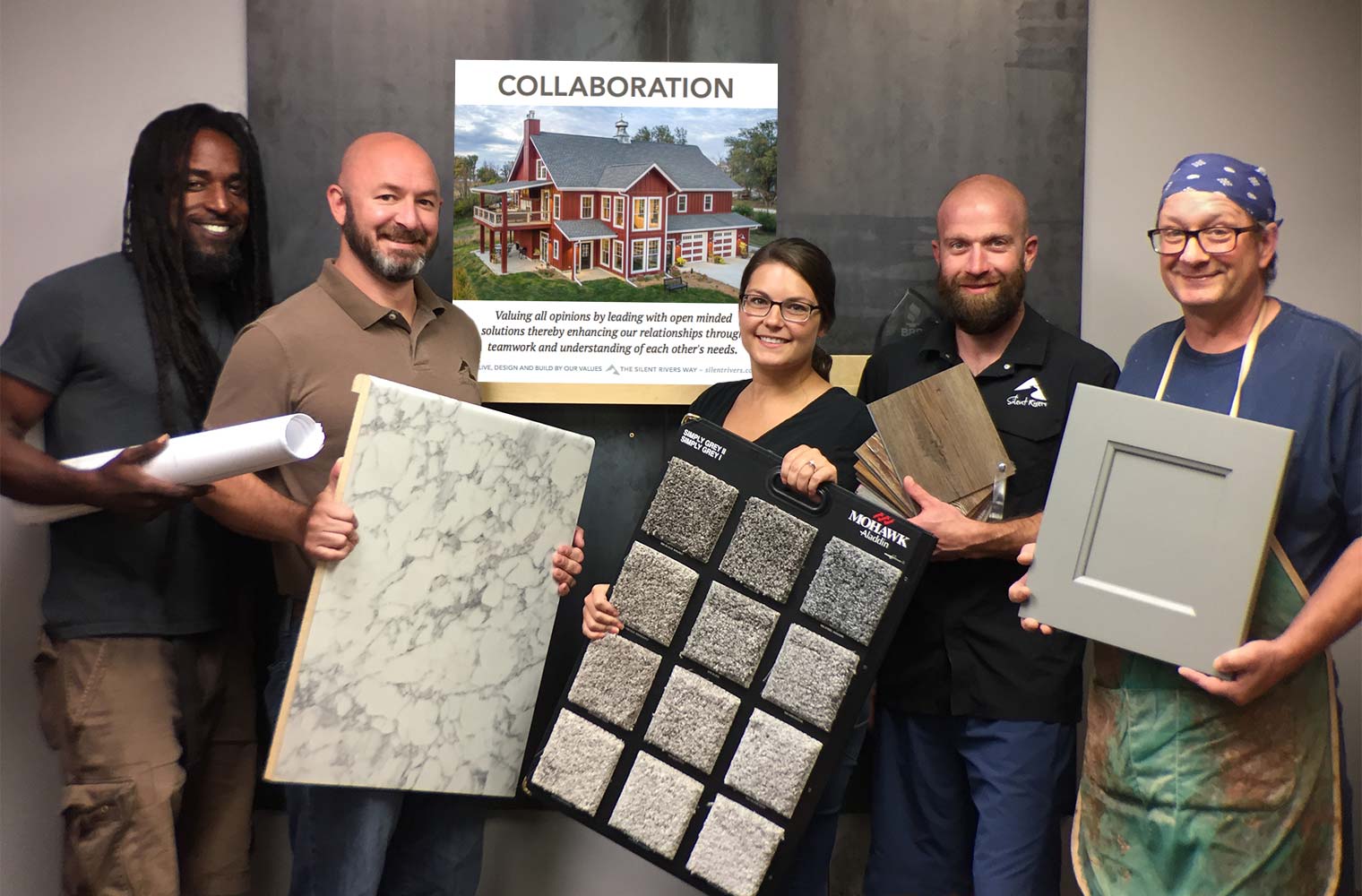Collaboration is key to our design+build process — between every member of our team and with every client. Each project starts with a client’s inspiration. Our designers share the following “dos & don’ts of home remodeling” to help our clients prepare for that wonderful collaborative process that balances remodeling ideas and remodeling budget.

The joy of collaboration at Silent Rivers! Here, designers David, Tyson and Amie pose with production manager Jason and woodshop manager Tom after meeting on a client’s remodeling project.
A successful design+build project is managed through the partnership of two major groups of players:
Partnership 1: Our team working with our clients to define goals, refine designs and make it clear what’s possible to achieve within your budget.
Partnership 2: Our designers, artisans, estimators and project managers working together to ensure accurate budgets, timelines and renowned Silent Rivers artistry.
Specific to the design phase of our design+build process, our designers seek to understand what our clients want and the investment they wish to make in their home. This results in design concepts presented as possibilities to achieve project goals. Our designers and estimators calculate investment value of each design concept, then collaborate with the client to hone in on the final design that best fits goals and budget.
To help clients prepare for this collaborative exchange, here are six helpful Dos & Don’ts of home remodeling.
1. Do gather inspiration in advance of first meeting.
Here are some great resources to help you express what is inspiring you to do your project.

A collage of inspirational images gathered by one of our clients helped us immediately understand the style she wanted for her bathroom remodeling project.
Houzz: Creating ideabooks on Houzz.com is a great way for designers and clients to share photos that convey style preferences, layout ideas and budget range. Add notes to each photo you save to express what you like – or don’t like, which is equally helpful for conveying your preferences. Keep in mind that Houzz caters to high-end design, and know that in many cases, Silent Rivers has resources for creating the look with less expense. How to create and use Houzz ideabooks »
Pinterest: Pin those ideas you see! Whether you find them on Pinterest.com or elsewhere on the internet, you can pin them to boards you create for sharing with your designer. Create boards for specific parts of your project, such as faucets and fixtures you like, cabinets that inspire you, layouts that work for your space, styles that move you. Rather than one big board loaded with all your ideas, this approach helps you communicate more clearly. In the comment section of each pin, be sure to include what draws your attention. If you like to go wild pinning every idea that excites you, that’s fine as long as you also plan to later review and delete pins as you edit down what you’re conveying to your designer. A newbie’s guide to using Pinterest »

We instantly understood the style our client desired for her new addition when she shared these favorite images she’d torn from design magazines and catalogs.
Magazines: Tearing pages from decorating magazines that inspire you and organizing them into a binder is still a great way to convey your ideas to your designer. Be sure to point out what you like or don’t like about each picture, and what about it inspires you or applies to your remodeling project. Is it the colors, textures, materials, layout, or how the space flows? Let us know! We are masters at assessing inspirational images and honing them into what serves the project and its budget.
2. Do make a must-have list and a wish list.
Managing any potential gap between remodeling aspirations and your budget is an important communication process stewarded by our designers, estimators and project managers. Clarity from you on your project priorities supports this. What must you absolutely have in your project? What would be nice to have if it fits in your budget? Perhaps opening up your space by removing walls is critical to you, and if that exceeds your budget, you are willing to choose a less expensive tile to keep everything in balance.
Defining must-haves and nice-to-haves offers a clearer idea of where to invest the bulk of your budget and where to save. Our designers are excellent at suggesting ways to get the look you want within a specific budget.
3. Do be open minded and trust in your design team.

Silent Rivers is a comprehensive team! Here, designers Caitlin and Amie review architectural plans with woodshop artisan Alex.
After going through the incredibly fun process of finding ideas and prioritizing them, know that your designer will see your vision and may be able to take it farther, scale it down for your budget or present a new possibility you hadn’t considered. This is the joy of collaborating with an experienced designer.
Trust that your project is in good hands and open yourself to the possibilities that come from the collaborative process. You are in partnership with your design team, and everyone is working toward the same vision… Your vision!
4. Don’t expect that your inspiration images and your budget are going to perfectly align.
It’s important to admit when your inspirations are actually lofty aspirations that are out of scale with the amount of money you plan to invest. This is why Silent Rivers approaches the estimation process with such detail and accuracy. It allows you to see where your vision might be higher than the budget you planned.
From there, work with your design team as they present options to help you decide whether to extend your budget or scale your project.
5. Don’t under emphasize the importance of design as part of your total remodeling budget.
Good design is worth every penny. You want a space that looks nice and functions tremendously. Designing spaces that achieve both takes a lot of experience, training and constant synchronicity with building and remodeling trends, methods and problem solving.
Throughout our 25 years in business, we know that design fees are typically 10% of the overall job. And design fees are worth it to avoid costly change orders once building begins! Plus, a thorough design process ensures an accurate estimate of building and materials.
Therefore, if you are planning a $100,000 remodeling project, approximately $10,000 of your investment will be in the design process while the remaining $90,000 will be in the building and materials cost. Some jobs require less extensive design resulting in fewer design hours. Smaller jobs often have a higher percentage of design fees compared to overall project costs since time is incurred for design yet there is less material used in a small space.
Beyond the building and remodeling industry’s golden rules, deep experience in our industry develops vast knowledge of materials, techniques and solutions. It takes time to arrive at a set of detailed architectural plans before they can be executed with excellence.
6. Don’t expect the process to be what you see on TV.
Sometimes, we need to communicate the reality of construction. HGTV is truly a great resource when considering a home remodel. And it’s important we let you know the processes you see on TV are typically scripted and therefore not completely realistic, as you probably suspected.
Bathroom remodels of that calibre don’t cost $3,000, the finished product doesn’t magically appear after three days and clients actually do need to be involved with design decisions along the way. We absolutely love Chip and Joanna Gaines and also want our clients to know we will not karate chop their walls.
Our approach to deconstruction is careful, considerate and involves salvaging materials that can be reused or donated. See our article on how we protect your home during remodeling.

Silent Rivers architect David Houston assesses existing plumbing and electrical on a project during the deconstruction process.
Ultimately, our goal is to create a finished project that our clients will immensely enjoy. As the client, you are who will look at the space every day and your input is critical!


